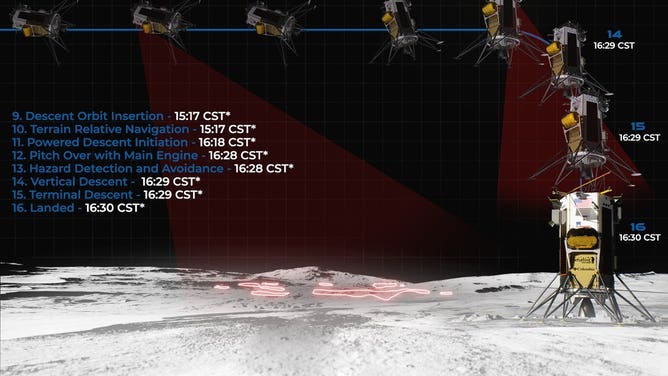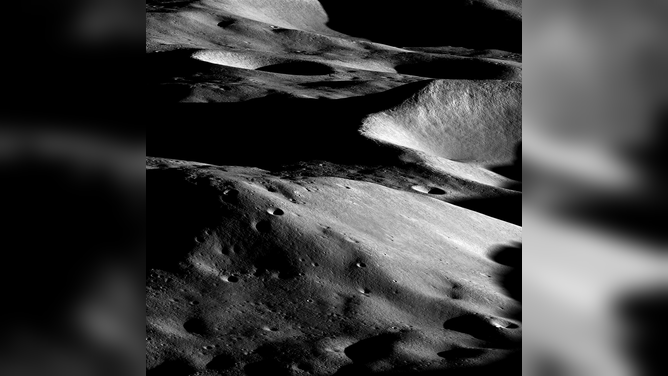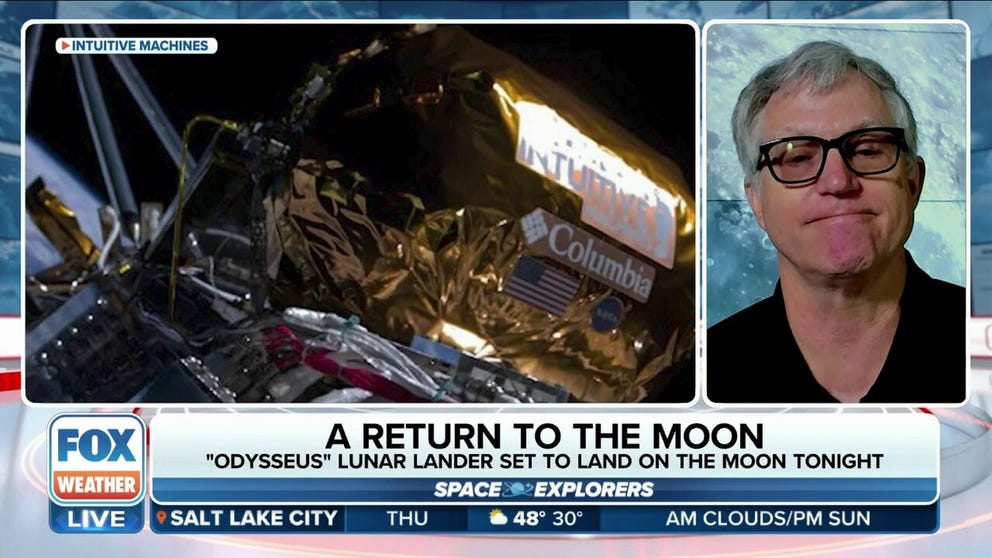Intuitive Machines waiting to confirm status of Moon lander Odysseus after landing attempt
The Nova-C lunar lander, known as Odysseus, is expected to land near the Moon’s South Pole at 6:24 p.m. EST Thursday. If successful, the landing will mark the first U.S. mission the Moon since Apollo 17 and the first triumphant private mission.
UPDATE: Intuitive Machines Moon lander Odysseus successfully landed on the lunar surface with NASA science making history on Thursday evening. Continue to follow FOX Weather's coverage post-landing here.
HOUSTON – Intuitive Machines’ Moon lander carrying NASA science completed a high-risk attempt to land on the lunar South Pole, which could mark the first private mission to touch down on the Moon,however, the company is waiting to hear what condition the lander is in.
Thursday's landing attempt comes just nine days after SpaceX launched the Nova-C spacecraft known as Odysseus from Kennedy Space Center in Florida and weeks after Astrobotic's foiled attempt to send a robotic mission to the Moon. Both American companies have contracts to fly NASA lunar science as part of the agency's Commercial Lunar Payload Services (CLPS) program.
LUNAR LANDER CAPTURES STUNNING PHOTOS OF EARTH BEFORE MOON LANDING ATTEMPT
Intuitive Machines' mission, known as IM-1, was set to deliver six NASA science payloads and commercial technologies to the lunar South Pole region known as Malapert. The hexagonal-shaped lander is about the size of the British phone box made famous as the time-traveling Tardis in the "Dr. Who" science-fiction series.
After a tense landing sequence, the landing time at 6:24 p.m. ET came and went, but mission control was still waiting to hear back from the lander. After more than 10 minutes, a faint signal was detected.
"We can confirm, our equipment is on the surface of the Moon," mission control said.
Teams continue to try and refine the signal from Odysseus.
A lunar landing is an engineering challenge only five nations have completed, and no private company has ever successfully landed on the Moon. If successful, this will mark the first private Moon landing and the first American landing since Apollo 17 in 1972.
"All the news we’re hearing from Intuitive Machines says they’re in good shape and ready to go," NASA CLPS Program Manager Chris Culbert told FOX Weather.
Nova-C Moon landing time continues to change
A day before the landing attempt, Intuitive Machines completed the lunar orbit insertion burn, placing the craft in a circular orbit about 60 miles above the Moon. The company said the spacecraft is in "excellent health."
On Thursday, the spacecraft completed its descent orbit insertion around 5 p.m. ET and continued to lower its orbit by using Terrain Relative Navigation to guide itself to the landing area. Odysseus must slow from about 4,000 mph to a soft landing on the Moon at a velocity of about 1 meter per second (about 2 mph).
The landing was expected at 6:24 p.m. ET.
After the initial orbit, Intuitive Machines started sharing images of the Moon taken by Odysseus’ Terrain Relative Navigation camera.
Each time Odysseus orbits the Moon, Intuitive Machines' mission control in Houston will have about 75 minutes of communication with the spacecraft and then a 45-minute expected blackout.
The timing of the soft touchdown on the lunar surface has shifted several times as flight controllers use additional orbits before starting the IM-1 mission landing sequence.
The landing was originally expected before 6 p.m. EST. After a lunar correction maneuver to raise Odysseus' orbit, the landing moved up more than an hour before flight controllers opted to loop the spacecraft around the Moon one more time.
"Flight controllers chose to exercise an additional orbit before starting the IM-1 Mission landing sequence. The new anticipated landing time is 1724 CST (6:24 p.m. ET)" Intuitive Machines said on X.
Flight controllers expect about a 15-second delay before they can confirm the landing.

The landing timeline for Intuitive Machines' Nova-C Moon lander. (Image: Intuitive Machines)
How cameras help find the perfect landing spot
Redwire Space Program Manager Carson Brooks is in Houston as the on-site lead for the SpectraCAM, two high-resolution cameras on the Nova-C lander, a key part of the lunar landing sending back images of the Moon in black-and-white.
One of the cameras will help the lander determine its designated landing site. At 30 meters (about 98 feet) above the lunar surface, Intuitive Machines will determine if there is a safe landing zone and whether the spacecraft continues forward.
"It is an extremely quick turnaround using the Intuitive Machines onboard software processes to get that information to the spacecraft to determine if what they're looking at in front of them at about a 45-degree angle is a safe landing zone," Brooks said.
At 10 meters (about 33 feet), there are no more cameras because of lunar dust, "and they will attempt the first lunar landing," she said.
Where is Odysseus landing on the Moon?
NASA science hitches a ride to Moon with Intuitive Machines lander
NASA CLPS program manager Chris Culbert explains what science payloads NASA is sending to the Moon with the Intuitive Machines Moon lander.
The Odysseus target landing area is about 186 miles from the lunar South Pole in an area known as Malapert, named after the 17th-century Belgian astronomer Charles Malapert. The area is near the lunar mountain Malapert Massif, one of NASA's lunar landing candidate sites for the Artemis III astronaut mission.

NASA's Lunar Reconnaissance Orbiter captured this view on March 3, 2023. Malapert Massif, a lunar mountain and Artemis 3 candidate landing region, is shown at lower left. The mountain's highest point looms more than 16,400 feet (5000 meters) above its base. (Image: NASA/GSFC/Arizona State University)
(NASA)
NASA and the private space industry want to visit the Moon's South Pole because it likely contains water ice, which can be mined for fuel and other resources, instead of launching those supplies to the Moon.
If the landing is successful, Intuitive Machines expects to provide power for its payloads for about a week before lunar night sets on the South Pole.
